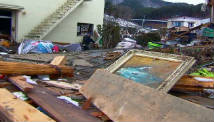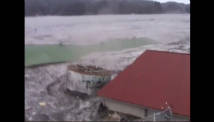Research ship finds the world's oceans are 'plasticized'
May 22, 2012 -- Updated 1403 GMT (2203 HKT)
STORY HIGHLIGHTS
- A research expedition has found plastic in the last unexplored part of the ocean
- The crew, which includes packaging experts, is studying the effects on marine life of plastic pollution
- It will next attempt to measure the density and toxicity of Japanese tsunami debris
- Plastic in the ocean has increased 100-fold in the last 40 years, scientists estimate
Organized by two non-profit groups -- the Algalita Marine Research Foundation and the 5 Gyres Institute
-- the expedition is sailing from the Marshall Islands to Japan through
a "synthetic soup" of plastic in the North Pacific Ocean on a 72-feet
yacht called the Sea Dragon, provided by Pangaea Exploration.
The area is part of one
of the ocean's five tropical gyres -- regions where bodies of water
converge, with currents delivering high concentrations of plastic
debris. The Sea Dragon is visiting the previously unexplored western
half of the North Pacific gyre -- situated below the 35th parallel, and
home to a massive expanse of plastic particles known as the "Great
Pacific Garbage Patch" -- to look for plastic pollution and study its
effect on marine life.
Leading the expedition is Marcus Eriksen, a former U.S. marine and Ph.D student from University of Southern California.
Our nets come up with a handful of plastic fragments at a time, in every trawl we've done for the last thousand miles.
Marcus Eriksen, expedition leader
Marcus Eriksen, expedition leader
"We've been finding lots
of micro plastics, all the size of a grain of rice or a small marble,"
Eriksen said via satellite phone. "We drag our nets and come up with a
small handful, like confetti -- 10, 20, 30 fragments at a time. That's
how it's been, every trawl we've done for the last thousand miles."
Eriksen, who has sailed
through all five gyres, said this confirmed for him "that the world's
oceans are 'plasticized.' Everywhere you go in the ocean, you're going
to find this plastic waste."
 First wave of tsunami debris hits U.S.
First wave of tsunami debris hits U.S.
 Quake, tsunami debris threaten coastlines
Quake, tsunami debris threaten coastlines
 Japan quake debris moving toward Hawaii
Japan quake debris moving toward Hawaii
Besides documenting the
existence of plastic pollution, the expedition intends to study how long
it takes for communities of barnacles, crabs and molluscs to establish,
whether the plastic can serve as a raft for species to cross
continents, and the prevalence of chemical pollutants.
On a second leg from Tokyo to Hawaii departing May 30, the team expect to encounter material dislodged by the Japanese tsunami.
"We'll be looking for
debris that's sub-surface: overturned boats, refrigerators, things that
wind is not affecting," Eriksen said. "We'll get an idea of how much is
out there, what's going on and what it's carrying with it, in terms of
toxins."
Scripps Institute graduate Miriam Goldstein
was chief scientist on a similar expedition to the Great Pacific
Garbage Patch in 2009. According to her research, there has been a
100-fold increase in plastic garbage in the last 40 years, most of it
broken down into tiny crumbs to form a concentrated soup.
The particles are so
small and profuse that they can't be dredged out. "You need a net with
very fine mesh and then you're catching baby fish, baby squid --
everything," Goldstein says. "For every gram of plastic you're taking
out, you probably take out more or less the equivalent of sea life."
We don't necessarily want an ocean stuffed with barnacles
Miriam Goldstein, scientist
Miriam Goldstein, scientist
Scientists are worried
that the marine organisms that adapt to the plastic could displace
existing species. Goldstein said this was a major concern, as organisms
that grow on hard surfaces tend to monopolize already scarce food, to
the detriment of other species.
"Things that can grow on
the plastic are kind of weedy and low diversity -- a parallel of the
things that grow on the sides of docks," she says. "We don't necessarily
want an ocean stuffed with barnacles."
Eriksen says the mood on
the Sea Dragon has been upbeat, with crew members playing a ukulele and
doing yoga, "but the sobering reality is that we're trawling through a
synthetic soup."
Also on board is Valerie Lecoeur, founder of a company that makes eco-friendly baby and children's products, including biodegradable beach toys made from corn, and Michael Brown from Packaging 2.0, a packaging consultancy.
Eriksen says they have been discussing the concept of "extended producer responsibility".
"As the manufacturer of
any good in the world today, you really can't make your product without a
plan for its entire use, because you could eventually have 7 billion
customers buy your product," he said.
"If one little button
has no plan, the world now has a mountain of buttons to deal with. There
is no room for waste, as a concept or a place -- there's just no place
to put it anymore. That's the reality we need to face. We've got this
plastic everywhere."

 Expeditions to ocean gyres
sometimes encounter 'ghost nets' - discarded fishing equipment that can
tangle into a hazard for marine organisms.
Expeditions to ocean gyres
sometimes encounter 'ghost nets' - discarded fishing equipment that can
tangle into a hazard for marine organisms.
ไม่มีความคิดเห็น:
แสดงความคิดเห็น